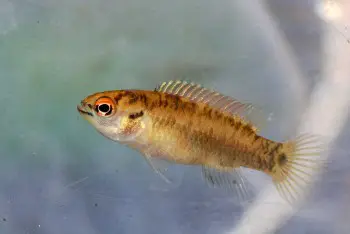New loaches from Myanmar

Schistura puncticeps, ZRC 53783, paratype, 55.2 mm SL; Myanmar: Shan State: mouth of Nam Paw, shortly after capture. © Bohlen and Šlechtová
A number of new loaches are covered in the latest volume of the journal ‘Ichthyological Exploration of Freshwaters‘, and among them are three species from Myanmar described by Jörg Bohlen and Vendula Šlechtová.
The first, Schistura puncticeps, is currently known only from its type locality, the mouth of Nam Paw stream at its confluence with the Myitnge River, itself a tributary of the Irrawaddy (aka Ayeyarwady) River in Shan state, northeastern Myanmar.
It can be told apart from other Schistura species by the following combination of characters: dorsal and lateral surfaces of the head covered by dark brown dots; 5-8 large brown blotches along the lateral midline of the body; a large head (head length 20.7-24.9 % SL); a short caudal peduncle (caudal peduncle length 12.2-13.4 % SL); a large eye (4.8-6.6 % SL); no discernable sexual dimorphism.
The specific name is derived from the Latin punctum, meaning ‘dot’, and ceps, a derivation of caput meaning ‘head’, in allusion to the prominently spotted head.
For further information refer to the full, open access paper: Bohlen, J. and Vendula Šlechtová. 2013. Schistura puncticeps, a new species of loach from Myanmar (Cypriniformes: Nemacheilidae). Ichthyological Exploration of Freshwaters 24(1): 85-92
The other two appear to be miniature species and closely-related to one another.

Schistura rubrimaculata; ZRC 53774, paratype, 26.1 mm SL; Myanmar: Magway division: stream Man Chaung; shortly after capture. Right side, reversed. © Bohlen and Šlechtová
S. rubrimaculata is named in reference to the red spot present on either side of the caudal peduncle in live specimens, and can be distinguished from congeners by the following combination of characters: small size (largest known specimen 27.7 mm SL); slender body shape (maximum body depth 103-123 % of body depth at nape); ventral half of body and head white (with silver sheen in life); colour pattern on body composed of a prominent black midlateral stripe and up to six small dorsal saddles; all fins hyaline; dark blotch on base of central unbranched caudal-fin rays, with a median incision at its posterior margin; and a distinct red dot on the side of the caudal peduncle in life, fading when preserved.
It’s been collected from the Man Chaung and Shwe Chaung river systems, both of which are Irrawaddy tributaries draining the eastern slope of the Rakhine Yoma mountains.

Schistura pawensis; ZRC 53776, holotype, 31.3 mm SL; Myanmar: Shan State: Hsipaw; shortly after capture. Right side, reversed. © Bohlen and Šlechtová
Schistura pawensis was discovered at the same locality as S. puncticeps and is named in reference to the Nam Paw stream.
Its distinguishing characters are as follows: body small (largest known specimen 31.3 mm SL); slender body shape (head depth at nape 1.1-1.2 times in body depth); all specimens with a prominent black midlateral stripe; entire ventral side silvery-white; 6 ½ or 7½ branched dorsal-fin rays; 7-8 + 8 branched caudal-fin rays; anus positioned halfway between pelvic-fin origin and anal-fin origin.
For further information see the full, open access paper: Bohlen, J. and Vendula Šlechtová. 2013. Two new species of Schistura from Myanmar (Teleostei: Nemacheilidae). Ichthyological Exploration of Freshwaters 24(1): 21-30.
All three species were collected in shallow, clear, flowing water over beds of gravel and do not appear to have entered the ornamental trade to date.
Thanks to Jörg Bohlen.
Category: Blogs, Ichthyology | Tags: aquarium, Bohlen, fishkeeping, Ichthyological Exploration of Freshwaters, ichthyology, Irrawaddy, loach, Myanmar, Schistura, Šlechtová | Comment »






Product reviewers wanted
Are you still looking for product reviewers?
19th Dec 2024
Product reviewers wanted
Hey! Interesting article!
17th Dec 2024
Site improvements
Got it! Thanks for the update. It's good to know that Seriously Fish is working on improving the site's performance and addressing the email and forum...
21st Nov 2024
Responsive design
Nice
13th Nov 2024
Responsive design
it is a complete malfunctioning horror on iphone and ipad.
10th Nov 2024